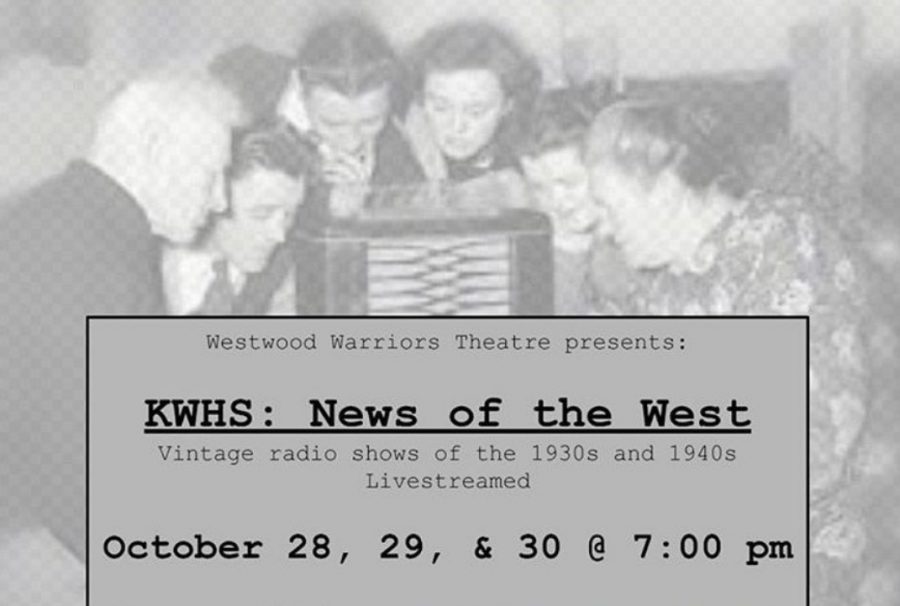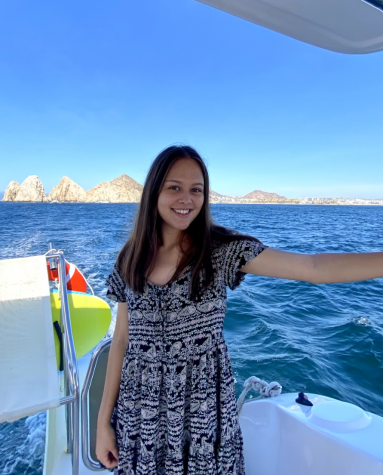Westwood Theatre Brings a Spectacular Performance to Three 1940s Classic Radio Plays
@wwdramaclub
Westwood Theatre held a production of three radio plays from Wednesday, Oct. 28 to Friday, Oct. 30. Photo courtesy @wwdramaclub
November 1, 2020
Westwood Theatre wowed the audience with their virtual production of three radio plays from Wednesday, Oct. 28 to Friday, Oct. 30. The three plays, set in the 1940s, revolved around the three main characters, Ronald, Mary, and Richard, played by Luc Brown ‘23, Cameron Hewett ‘22, and Baker Tuthill ‘23 respectively.
The first radio play was The Hitchhiker, written by Lucille Fletcher. It told a story about Ronald Adams, played by Brown, who drives across the country from Brooklyn, New York to California. Along the journey, he sees the same hitchhiker along the road despite the fact that there would be no way for the hitchhiker to randomly appear in these locations. His random visions ruin his companionship with another hitchhiker, whom he spots along the way and picks up. After deeming Adams crazy, the hitchhiker flees from the car, leaving him alone in the Texas prairie. Adams continues to drive until he finds a payphone in a gas station. He calls his mother, thinking that she will reassure him. A woman he doesn’t know picks up the phone and states that Mrs. Adams is in the hospital due to a nervous breakdown after hearing her son had died in a car accident on the Brooklyn Bridge. Adams realizes that he is dead, after his first acquaintance with the first hitchhiker. As the radio play ends, Adams expresses his determination to find the hitchhiker but is afraid he isn’t able to due to what he heard from the woman in the call.
Throughout the first radio play, I was impressed by how smoothly each actor transitioned from their lines and scenes. There were few pauses, showing that everyone was experienced with the technology they were given. The greenscreens were also a nice touch in the play. They weren’t overbearing and were only used at the necessary times. I admired how each actor was able to wear something that represented their character. Given the circumstances, I understand that complex costumes aren’t possible, but it was interesting to see how the actors still found a way to incorporate some detail into their clothing.
The second radio play was Death Calls at Dinner, written by Alexander Woollcott. The play focused on the death of Sam, who died of a heart attack during his anniversary dinner. Sam’s wife, Mary, played by Hewett, was accused of killing her son after Officer Mike and Sergeant Barker, played by Emma Portnoy ‘23 and Brown, noticed a silver spoon becoming tarnished after being put into the black coffee.
I especially enjoyed the props here. The actors were able to “pass around” the spoon incorporating more realism into the play. The costumes in this production also particularly stood out to me. It was easy to distinguish the sergeant and officer from the people eating at the table.
“I think Death Calls at Dinner went really well each time we performed,” Hewett said. “Everyone was onto their cues which is great. At the beginning of rehearsals, we had trouble looking in the correct directions to make it seem like we were actually facing that person in real life but once the show came around all of that came along perfectly.”
The third and final radio play was The 39 Steps, written by Joe Landry. The romantic thriller left viewers on the edge of their seats. Richard Hannay, played by Tuthill, meets Annabella Smith, played by Cara Tome ‘22, who is running from foreign agents, after a disturbance at a music hall. After Smith gets murdered, Hannay gets entangled in the situation and tries to break away from the spy ring to prove his innocence. An epic train chase follows, where Hannay is able to meet Pamela, played by Lucy Wang ‘21, who indecisively helps Hannay to try to clear his name.
I enjoyed the actor’s efforts to face each other during this radio play. Not only did it give it a more realistic effect, but it also showed a connection between Pamela and Hannay leading up to the end of the play. Wang did a fantastic job showing Pamela’s character growth from being a double-crosser to showing empathy towards Hannay.
The three radio plays posed many challenges for crewmembers. For one, the production was held on Zoom; something that had never been done before. The actors were able to smoothly communicate with each other without any huge troubling technical difficulties. The quick transitions, greenscreens, and props especially impressed me. Everything flowed together given the circumstances.
“The play went well and it was a very exciting and learning filled process,” Brown said. “The fact that it was all virtual posed some challenges from the acting standpoint in that we didn’t have a physical space to act in and it was harder to bounce off [of] our other co-stars. Another challenge was the fact that no one in the production had ever done a show like this so everyone was learning along the way.”
Not only did this play showcase the actors ability to portray an older time scene well, but it also allowed the actors to expand their own knowledge on the use of online tools for virtual performances.
“I think the show went really well,” Emma Goolsbey ‘21 said. “We’ve never done a show over Zoom before, but everyone worked really hard despite all that to create a great performance. I’m so glad I could be a part of such a unique production full of wonderful people for my last fall show at Westwood.”
Overall, the cast did a fantastic job with the three radio plays. Everything from the props, to the costumes, to the sound effects were well thought out. With such an amazing performance, I’m excited to see what the spring show will bring.




Hannah Ashtari • Nov 9, 2020 at 4:38 pm
This is a really great story Amy!! I’m glad you wrote it because I didn’t get the chance to see the play, so thank you! <3